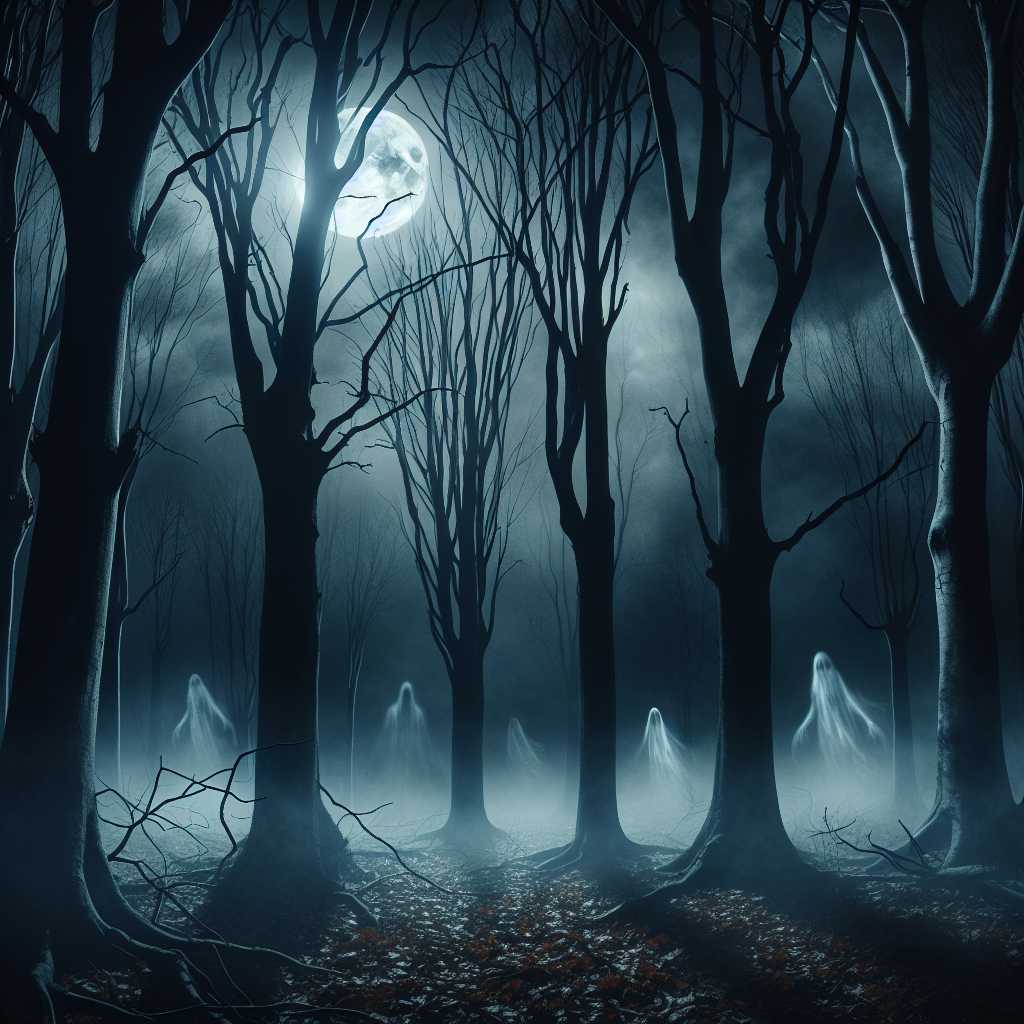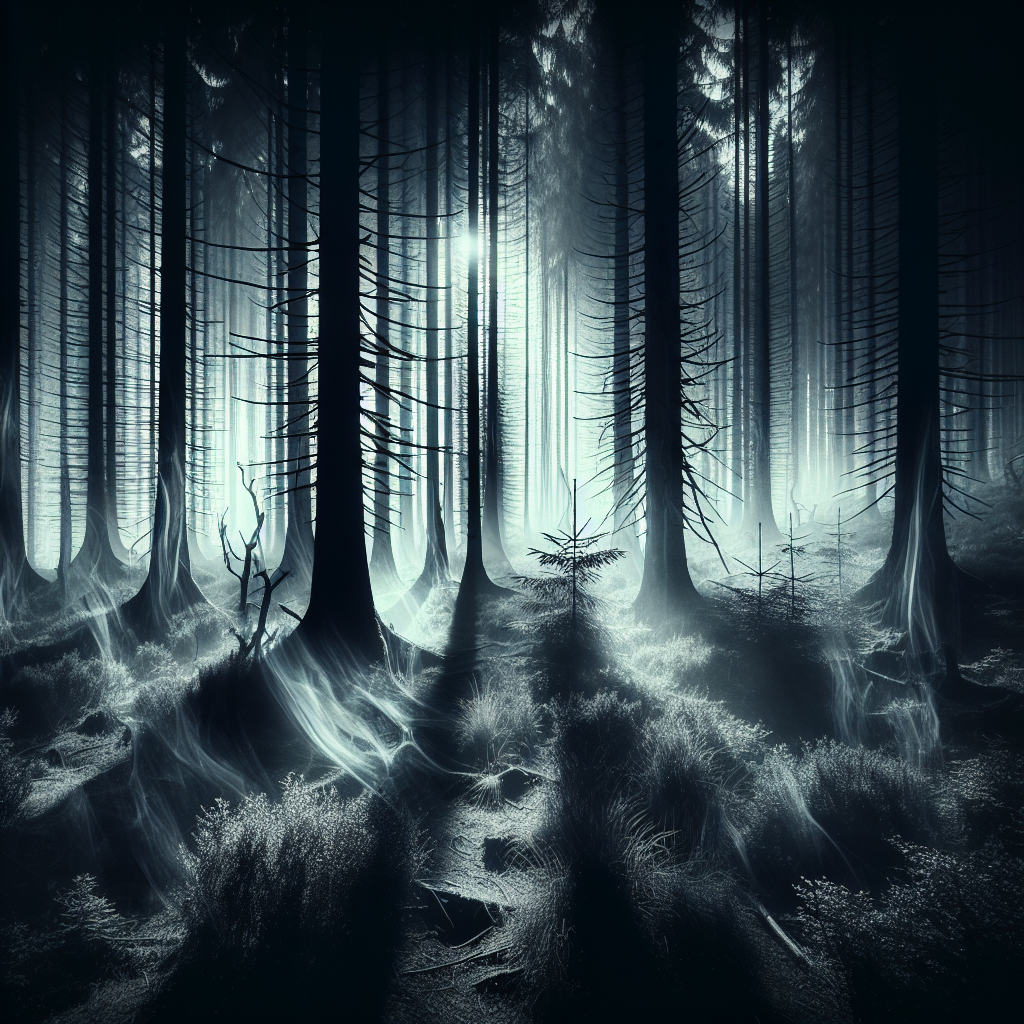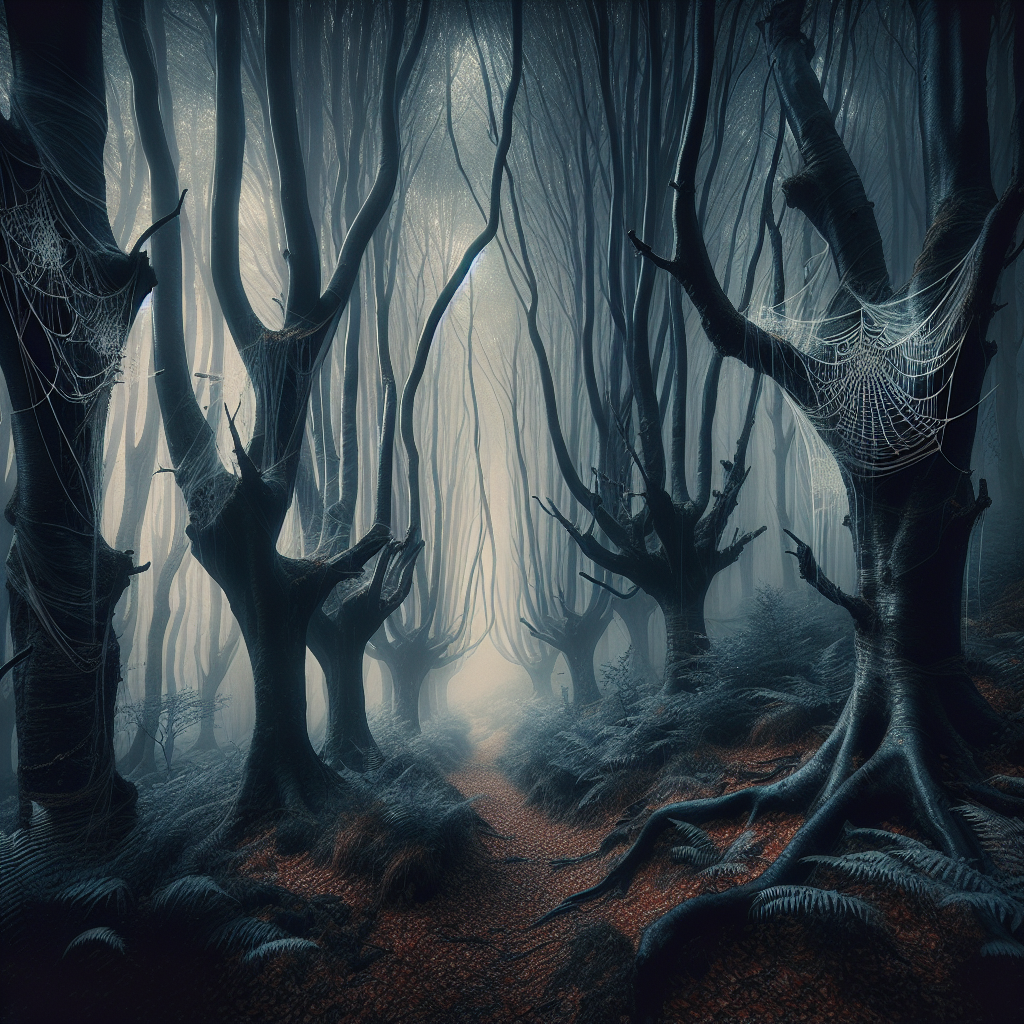Deep within the heart of enchanted forests lie hidden mysteries and chilling tales that have been passed down through generations – the haunting Gothic legends of restless spirits. These spectral entities are believed to roam the shadowy woods, their ethereal presence sending shivers down the spine of any brave soul who dares to venture into their domain. From ghostly apparitions to solemn whispers in the wind, these eerie tales of spectral beings reflect the dark and twisted history of the haunted forests they inhabit. Join us on a journey as we unravel the secrets of these enigmatic Gothic legends, and delve into the mysterious world of haunted forests with restless spirits.
The Enigmatic Allure of Haunted Forests
In the realm of Gothic culture, forests hold a profound historical significance that transcends mere physical landscapes. These dense, shadowy woodlands have served as the backdrop for countless tales of mystery, suspense, and supernatural phenomena, captivating the imaginations of storytellers and audiences alike. The very essence of a forest, with its twisted trees, hidden clearings, and ominous silence, embodies an otherworldly quality that lends itself perfectly to the eerie narratives of the Gothic tradition.
One of the most intriguing aspects of haunted forests is the pervasive connection between these enigmatic landscapes and the restless spirits that are said to inhabit them. Throughout folklore and legend, forests have been depicted as liminal spaces where the boundaries between the living and the dead blur, allowing for the manifestation of spectral entities seeking to interact with the mortal realm. These spirits, often trapped in a state of unresolved torment or driven by malevolent intent, are believed to wander the darkened paths of haunted forests, forever bound to their earthly confines.
Delving into Gothic Legends of Haunted Forests

Origins of Haunted Forest Myths
-
Tracing back to ancient folklore and superstitions
Ancient civilizations across the globe harbored beliefs in spirits residing in forests, attributing natural phenomena to the presence of these otherworldly entities. From the Celtic druids’ reverence for sacred groves to the Japanese folklore of malevolent forest spirits known as Yokai, the roots of haunted forest myths run deep in human history. These early beliefs laid the foundation for the ominous reputation that many forests hold in modern times.
-
Evolution of forest spirits in Gothic literature and legends
The Gothic literary movement of the 18th and 19th centuries further popularized the portrayal of forests as eerie settings teeming with supernatural beings. Authors like Edgar Allan Poe and Nathaniel Hawthorne wove intricate tales of haunted woods inhabited by vengeful spirits and lost souls. These stories not only captivated audiences with their macabre imagery but also solidified the association between forests and the paranormal in the collective imagination. The evolution of forest spirits in Gothic literature transformed ancient folklore into enduring tales of mystery and dread.
Notable Haunted Forests in Gothic Lore
Delving into Gothic Legends of Haunted Forests
Transylvania’s dark and eerie Hoia Baciu Forest:
The Hoia Baciu Forest in Transylvania, Romania, is shrouded in mystery and eerie tales. Locals believe it to be a hotbed of paranormal activity, with reports of ghostly apparitions, unexplained shadows, and inexplicable electronic malfunctions. The forest’s twisted trees and dense foliage add to its foreboding atmosphere, making it a hotspot for those interested in the supernatural.
Germany’s sinister Black Forest with its ghostly tales:
The Black Forest in Germany is not only known for its picturesque landscapes but also for its dark and sinister reputation in Gothic lore. Legends speak of wandering spirits, spectral beings, and mysterious disappearances within its depths. The dense canopy of trees, ancient folklore, and the pervasive sense of unease make the Black Forest a magnet for ghost hunters and thrill-seekers alike.
The haunted depths of Japan’s Aokigahara Forest:
Aokigahara Forest, located at the base of Mount Fuji in Japan, is infamous for its association with death and despair. Also known as the “Suicide Forest,” it has a tragic reputation as a site where individuals go to end their lives. The dense foliage, eerie silence, and the somber presence of makeshift memorials create a chilling atmosphere that has sparked numerous ghost stories and legends surrounding the restless spirits said to roam its haunted grounds.

Unveiling the Restless Spirits Within
Types of Spirits Haunting Forests
-
Vengeful Spirits Seeking Retribution
Vengeful spirits in haunted forests are believed to be entities driven by a deep sense of anger or injustice. These spirits are often associated with tragic or violent events that occurred in the past, leading them to seek retribution against those they perceive as responsible. Their presence is marked by feelings of malevolence and a desire to inflict harm on unsuspecting visitors. -
Lost Souls Trapped in a Perpetual State of Unrest
Lost souls haunting forests are spirits caught between the realms of the living and the dead, unable to find peace or closure. These spirits are often characterized by a sense of confusion and despair, wandering aimlessly through the trees in search of resolution. Their presence can evoke feelings of sadness and melancholy, as they yearn for release from their eternal torment.
The Haunting Manifestations
In the eerie depths of haunted forests, whispers drift through the dense foliage like ethereal tendrils, chilling the very air with their spectral presence. These eerie whispers are often reported by brave souls who dare to venture into the heart of these mysterious woods, their source inexplicably elusive yet undeniably haunting.
Accompanying the unsettling whispers are phantom footsteps, echoing through the shadowed paths with an otherworldly cadence. Visitors to these haunted forests speak of a sensation of being followed, of unseen entities treading the forest floor alongside them, their presence palpable yet invisible to the naked eye.
Perhaps most chilling of all are the apparitions that manifest amidst the twisted trees, bygone souls from ages past who wander the forest with a sense of purpose or a burden left unfulfilled. These spectral figures are said to materialize out of the mist, their forms translucent and shimmering, evoking a sense of profound sorrow and longing in those who bear witness to their silent lament.
Exploring the Psychological Impact
- The primal fear of the unknown lurking within forests
Delving into the psychological impact of haunted forests, it becomes evident that the primal fear of the unknown plays a significant role in shaping our perceptions. The dense foliage, twisted trees, and eerie silence of these wooded areas evoke a sense of foreboding, triggering our innate fear response. Our minds, wired through evolution to be wary of environments that could conceal threats, heighten our senses in such settings, leading to heightened anxiety and apprehension.
- How Gothic legends of haunted forests tap into our deepest fears
The Gothic legends surrounding haunted forests capitalize on our deepest fears, intertwining elements of supernatural folklore with the unsettling atmosphere of these wooded realms. By weaving tales of restless spirits, vengeful entities, and malevolent forces lurking amidst the trees, these legends exploit our primal fears of the supernatural and the unknown. The narratives often amplify the sense of dread associated with these forests, fueling our imagination and perpetuating the aura of mystery and terror that surrounds them.
Debunking Myths and Separating Fact from Fiction
Rational Explanations for Supernatural Encounters
In the realm of haunted forests and their associated ghostly legends, it is crucial to delve into the rational explanations behind the reported supernatural encounters. While these encounters may seem inexplicable at first glance, a closer examination often reveals underlying factors that can demystify the perceived paranormal activity. By exploring the following rational explanations, we can begin to unravel the complex web of beliefs and fears surrounding haunted forests:
-
Psychological effects of isolation in dense forests: The dense, foreboding nature of haunted forests can evoke feelings of isolation and unease in individuals who venture into these mysterious realms. The human mind, when faced with such environments, may succumb to heightened levels of anxiety and fear, leading to perceived supernatural encounters. The psychological impact of isolation in these eerie settings can play a significant role in shaping the narratives of restless spirits and ghostly apparitions that are often reported by visitors.
-
Natural phenomena mistaken for paranormal occurrences: In many instances, what may appear to be supernatural phenomena in haunted forests can be attributed to natural occurrences that are misunderstood or misinterpreted. For example, eerie sounds echoing through the trees at night may be the result of wind rustling through branches or wildlife moving through the undergrowth. Similarly, strange lights flickering in the darkness could be explained by natural sources such as bioluminescent fungi or atmospheric conditions. By carefully examining these natural phenomena, we can debunk myths and separate fact from fiction in the realm of haunted forest legends.
Analyzing the Role of Perception in Haunted Forest Myths
In the realm of haunted forests and their associated legends, perception plays a crucial role in shaping individuals’ experiences and beliefs. The way we perceive our surroundings and interpret sensory information can greatly influence our understanding of purported hauntings within these mysterious woodlands. By delving into the intricate relationship between perception and haunted forest myths, we can gain valuable insights into the origins and perpetuation of these eerie tales.
How cultural beliefs shape our interpretation of forest hauntings
Cultural beliefs serve as a foundational framework through which individuals process and make sense of the supernatural occurrences reported in haunted forests. The customs, traditions, and folklore prevalent within a particular society can significantly impact how individuals perceive and interpret mysterious phenomena encountered in these wooded areas. For instance, societies with deep-rooted beliefs in spirits and the afterlife may be more inclined to attribute unusual events in forests to otherworldly entities, thus perpetuating the myth of haunted woods.
The power of suggestion in creating supernatural experiences

The power of suggestion plays a pivotal role in shaping individuals’ experiences within haunted forests. When individuals are primed with stories of ghostly encounters or paranormal activities associated with a particular woodland, their minds become more susceptible to perceiving benign stimuli as eerie or supernatural. This phenomenon, known as suggestibility, can lead individuals to interpret ordinary sounds, sights, or sensations within a forest environment as manifestations of restless spirits or malevolent entities. The collective reinforcement of these suggested beliefs can further solidify the notion of haunted forests in the collective consciousness.
Embracing the Mystique of Haunted Forests
The enduring appeal of Gothic legends in modern storytelling stems from their ability to tap into primal fears and desires, weaving narratives that blur the lines between the tangible and the supernatural. These tales often center around haunted forests, where the natural world merges with the eerie unknown, creating an atmosphere of suspense and intrigue that captivates audiences across generations.
The Timeless Allure of Exploring the Haunted Realms of the Forest
Venturing into the shadowy depths of a haunted forest evokes a sense of thrill and apprehension, as ancient trees whisper secrets of the past and unseen spirits stir in the undergrowth. The juxtaposition of beauty and danger in these wooded realms serves as a potent backdrop for stories of restless spirits and malevolent entities, drawing in those who seek to unravel the mysteries shrouded within the forest’s dark embrace.
In these haunted forests, every rustle of leaves and creak of branches becomes pregnant with possibility, fueling the imagination and igniting a primal sense of fear and wonder. It is within these enigmatic landscapes that Gothic legends find fertile ground, weaving tales of tragedy, betrayal, and redemption against a backdrop of twisted trees and shifting shadows.
FAQs: Unraveling the Mysterious Gothic Legends of Haunted Forests with Restless Spirits
What makes a forest haunted in gothic legends?
In gothic legends, a forest is said to be haunted when it is believed to be inhabited by restless spirits or other supernatural entities. These spirits are often thought to be the souls of those who have met tragic fates within the forest, leading to their spirit lingering in the area. The eerie atmosphere, mysterious sounds, and sightings of apparitions contribute to the haunting reputation of these forests.
What are some common themes in gothic legends of haunted forests?
Common themes in gothic legends of haunted forests include dark and foreboding atmospheres, mysterious disappearances, vengeful spirits seeking revenge, and the presence of malevolent forces that prey on unsuspecting travelers. The forests are often depicted as alive with malevolence, with twisted trees, thick fog, and eerie whispers adding to the sense of dread and unease.
Are there specific haunted forests that are famous in gothic folklore?
Yes, there are several haunted forests that have gained fame in gothic folklore. For example, the Black Forest in Germany is notorious for its legends of restless spirits and dark entities that are said to lurk within its dense foliage. The Hoia Baciu Forest in Romania is also known for its paranormal activity, with visitors reporting encounters with ghosts and unexplained phenomena. These forests have become iconic locations in gothic folklore, inspiring tales of terror and mystery.
How do gothic legends of haunted forests impact popular culture?
Gothic legends of haunted forests with restless spirits have had a significant influence on popular culture, inspiring countless works of fiction, film, and art. These eerie forests serve as the backdrop for chilling stories of supernatural encounters, haunted journeys, and the exploration of the unknown. The themes of darkness, fear, and mystery that are prevalent in gothic legends of haunted forests continue to captivate audiences and fuel their fascination with the supernatural.
